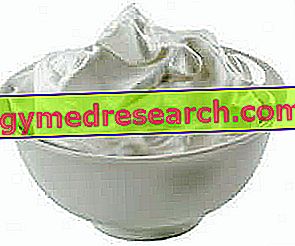What is that
Chantilly Cream, Custard or Diplomatic Cream?
According to some texts, the chantilly cream is a pastry base created in 1691 by the French chef Francoise Vatel; he, as head of catering at the court of Louis XIV, formulated the first chantilly cream by combining fresh cream, icing sugar and vanilla in berries.

- Whipped cream : "very cold" liquid fresh cream subjected to complete whipping.
- Chantilly cream: "very cold" liquid fresh cream left to flavor for several hours with vanilla pods, then filtered (with a cotton sieve) and subjected to complete whipping; at the end of the mechanical process, the chantilly cream is gradually added to icing sugar, incorporated from the bottom upwards without disassembling the finished product.
Chantilly Cream - Video Recipe -
Chantilly Cream - Recipe
X Problems with video playback? Reload from YouTube Go to Video Page Go to Video Recipes Section Watch the video on youtube- Vanilla custard : egg yolks whipped with granulated sugar, then tied with sifted type 00 wheat flour (or starch or cornstarch or rice flour etc.), then diluted and heat treated together with whole flavored cow's milk (vanilla berries), pre-heated and filtered. The custard is then returned to the fire until it reaches the right consistency (degree of solidity, absence of lumps) and possibly filtered with a Chinese colander. NB . It is better not to use the egg whites since they are responsible for the "gelation" of the cream, which should instead keep a consistency only "thick" (try the difference to understand!).
Custard - Video
How to make custard - Video Recipe - See also the light variant with few calories and that of chocolate custard
Light custard without butter
X Problems with video playback? Reload from YouTube Go to Video Page Go to Video Recipes Section Watch the video on youtube- Diplomatic cream : fruit of the union between vanilla custard and chantilly cream (delicate operation, to be carried out without removing the compound); the proportion between the bases varies depending on the desirable characteristics but, basically, corresponds to:
- 70% cream past. and 30% Chantilly cream for a "robust" diplomatic (stuffing);
- 50% cream past. and 50% Chantilly cream for a diplomatic "medium consistency" (filling and surface decorations);
- 30% cream past. and 70% Chantilly cream for a "light" diplomatic (surface decorations and in a cup / spoon).
Diplomatic cake - Video Recipe
diplomatic cake
X Problems with video playback? Reload from YouTube Go to Video Page Go to Video Recipes Section Watch the video on youtube- English cream : similar to custard but lighter to the touch. It is the fruit of the whipping of the egg yolks with the granulated sugar, then combined with whole cow's milk (flavored with vanilla as for the custard) brought to a temperature slightly higher than the pasteurization temperature (therefore around 80 ° C ). On the fire, keep the designated temperature until the cream reaches the right density. WARNING! Exceeding the optimal temperature leads to protein coagulation of the yolk, thus separating the English cream by making it "go crazy". For lovers of perfectionism it is advisable to thicken the custard in a bain-marie and not on the direct fire.
Recipe and nutritional properties
The various recipes for chantilly cream differ in some minor details. Certain formulations involve the use of fresh and pure cream with the addition (subsequent to assembly) of icing sugar, unlike others that suggest the use of already sweetened cream. In some versions of chantilly cream natural vanilla is preferred while in others the vanillin synthetic aroma appears. However, among the different types of chantilly cream there are no major chemical and nutritional variations, except those related to the quantity of simple added sugars (variable according to personal taste); on average, in traditional chantilly cream recipes we recommend a ratio between the volume of the liquid cream and the mass of the icing sugar equal to: 25: 2 (less sweet) or 20: 3 (sweeter).
Chantilly cream is an extremely caloric confectionery base, which is why it should NOT be included as a customary food, or systematically present, in a low-calorie diet aimed at weight loss. It is always inadvisable to consume it as a pure dessert and its presence in other recipes should be at least parsimonious.
From a nutritional point of view, the chantilly cream is rich in lipids and simple sugars, while proteins are quantitatively of little value. The chantilly cream fatty acids are mainly saturated and, evaluated in association with the relative cholesterol levels, make it a food NOT suitable for those suffering from hypercholesterolemia. Moreover, in the most sweetened formulations, the chantilly cream is considered a product to be avoided even in the diet against type 2 diabetes mellitus.
As far as mineral salts are concerned, there are no noteworthy additions, while, with regard to vitamins, the concentration of liposoluble A also referred to as retinol equivalents stands out.
The difference between the chantilly cream and the diplomatic cream (which we remember being the result of the union between chantilly cream and custard) involves a good part of the nutritional sphere. First of all, the chantilly cream is decidedly richer in fat and cholesterol, while the diplomatic one has a greater fraction of carbohydrates (including complex ones); ultimately, between the two creams, the most energetic is undoubtedly the chantilly. With regard to microelements instead, the only discrepancies to be highlighted are: the greater calcium content of the diplomatic cream and the best intake of vit. A or retinol equivalent of the chantilly cream.
Nutritional values
Nutritional composition per 100g of Chantilly Cream (values obtained from the average between the ratio 25: 2 and 20: 3) and per 100g of Diplomatic Cream (values obtained from a ratio 1: 1, or 50/50)
 | |||
| Edible part | 100.0% | 100.0% | |
| water | 52.68g | 56.72g | |
| Protein | 2.07g | 3.46g | |
| Prevailing amino acids | - | - | |
| Limiting amino acid | - | - | |
| Lipids TOT | 31.51g | 17.14G | |
| Saturated fatty acids | 18.43g | 10.57g | |
| Monounsaturated fatty acids | 8.96g | 5.69g | |
| Polyunsaturated fatty acids | 1.04G | 0.88g | |
| Cholesterol | 94.50mg | 144.00mg | |
| TOT Carbohydrates | 13.02g | 20.14g | |
| Starch | 0.17g | 2.23g | |
| Soluble sugars | 12.85g | 17.91g | |
| Dietary fiber | 0.0g | 0.07g | |
| Soluble | 0.0g | - g | |
| Insoluble | 0.0g | - g | |
| Power | 340.70kcal | 237.58kcal | |
| Sodium | 30.70mg | 33.13mg | |
| Potassium | 90.20mg | 101.63mg | |
| Iron | 0.00mg | 0.32mg | |
| Football | 4.00mg | 79.55.00mg | |
| Phosphorus | 54.90mg | 85.00mg | |
| Thiamine | 0.02mg | 0.04mg | |
| Riboflavin | 0.10mg | 0.15mg | |
| Niacin | 0.00mg | 0.06mg | |
| Vitamin A | 241.20 RAE | 161.18 RAE | |
| C vitamin | 0.90mg | 1.05mg | |
| Vitamin E | 0.77mg | 0.61mg | |



